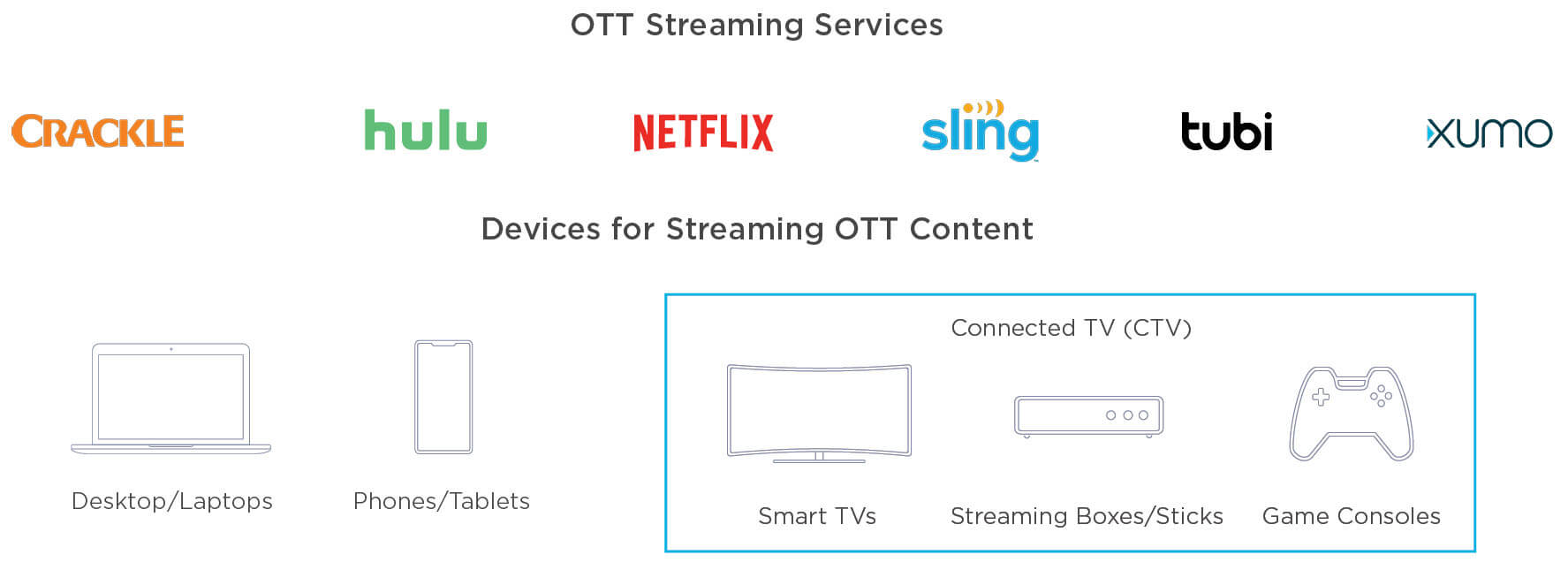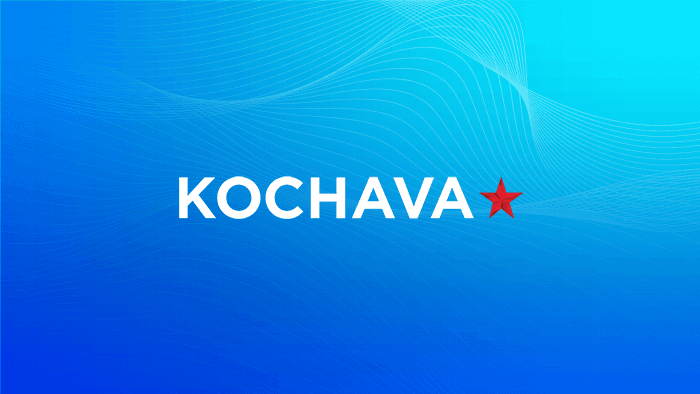Over-the-Top (OTT) | Definition
The term OTT refers to television and film streams “over the top ” of the internet directly to viewers, rather than through traditional broadcasts, cable, or satellite mediums. Content can be streamed “over the top” on connected TV (CTV) devices, desktop/laptop, mobile phones, and tablets from apps or websites. As a general rule of thumb, use OTT when you’re referring to the universe of content being streamed “over the top” of the internet.

Related Terms
The benefits of OTT advertising
Addressability and targeting: OTT advertising platforms can address specific households, and in certain cases even the different devices within those households, with targeted advertising based on holistic user/household profiles that include insights on:
- Demographics
- Points of interest visitation
- Brand affinity
- Interests and behaviors
- Precision geography
This enables microtargeting for maximum efficacy of ad spend. Further, due to household-level targeting, geofencing enables much more precise geographic-based targeting, which is particularly important for brick-and-mortar brands.
Viewability: An entire screen ad is hard to ignore, especially when it appears between episodes of your favorite show. Not only do OTT campaigns open up the advertisement space, the ads run on these platforms are viewed at a much higher completion rate. Further, Brand Innovators found that most of their survey respondents chose to run ads on OTT because “lighter ad loads keep audiences more engaged” as opposed to the heavily saturated mobile space.
Return on investment (ROI): With the mobile ad space saturated with advertisements, cost per install (CPI) rates have risen considerably along with cost per action (CPA) and cost per mille (CPM). The OTT space is premium inventory; however, direct targetability and high view completion rates often make running ads on OTT more cost effective in terms of ROI.
OTT advertising platforms
These are three main avenues for advertisers to buy media on OTT: programmatic, platform direct, and publisher direct. Each one comes with their benefits and drawbacks.
- Programmatic: One of the most effective and cost-efficient ways for advertisers to enter the OTT space is through programmatic platforms. Ad placement can be automated with programmatic bidding because of direct relationships between inventory exchanges and other OTT advertising platforms. Advertisers are able to target audiences viewing OTT content across multiple streaming services, platforms, and devices.
- Platform direct: Advertisers can choose to go directly to major platforms such as Roku, Vizio, Samsung, LG, etc., and buy inventory through the platform’s own exchange. While this is a very straightforward way to buy ad space, it can limit the campaign to that specific platform and doesn’t allow for cross-platform advertising.
- Publisher direct: Going directly to the publisher (Hulu, Sling, Paramount+, NBCUniversal, SKY, Rakuten, Crackle, etc.) is another option and allows for more control over ad inventory. However, like Platform Direct, Publisher Direct limits the advertiser’s campaign to that specific publisher’s content.
As a marketer, it’s important to choose the right platform for your OTT advertising to ensure successful campaigns.
Key metrics for OTT advertising
Click-through rate (CTR): Not all OTT ads are clickable, but click-through rate (CTR) is a metric that measures how often an advertisement is clicked (i.e. A viewer sees an ad on their Roku home screen and uses their remote to select it). CTR can be used to measure various types of campaigns, like OTT. This metric is used to understand what types of ad creatives and copy drive engagement and goal completions.
Video completion rate (VCR): VCR measures the average amount of time users view an ad through to completion. With OTT ads, this is an important metric to know because it tells marketers how engaging or effective their video ad is. The higher the VCR the better so test different forms of ads to see which one’s perform best. Marketers can also use the CVR to determine which audience segments have a higher VCR and target ads to that group. While some OTT streaming platforms may allow viewers to skip ads after some seconds (e.g. Skipping a YouTube ad after 5 seconds), other services may not offer this option.
Outcomes-based Attribution: The ultimate goal of OTT advertising is to increase the volume of users completing your desired business outcome or conversion. Measuring the success of OTT advertising requires attribution, which involves connecting the viewing of an ad (and possible click on an ad) to a specific desired action, like visiting a website, installing an app, or making an online purchase. This metric is crucial for OTT advertising because it helps track the effectiveness of specific ads in generating leads or sales, ultimately providing proof of the OTT campaign’s return on investment.
Total Impressions: Total impressions is a KPI that refers to the total number of times an ad is viewed by an audience. It’s the cumulative amount of exposure or views the piece of content has. In OTT advertising, the total impressions would be the count of everyone who saw an advertisement through an OTT device or service. This metric can help marketers measure the potential reach and exposure of a campaign.
Unique Reach: Unique reach is the total number of distinct users or viewers reached by a marketing campaign. Unlike total impressions, which could count multiple views by the same users, unique reach only identifies the unique user within the target audience within a specified time period. This metric gives insights into the actual number of users who have been exposed to the marketing campaign.
These are only a handful of the metrics that should be considered when utilizing OTT advertising. Depending on your product or service, these metrics can change.
OTT and Kochava
Kochava has been a leading mobile measurement partner (MMP) since 2011, and has grown to become the go-to provider for OTT measurement and attribution across both mobile and connected TV devices. The Kochava platform enables advertisers to measure the effectiveness of their omni-channel marketing campaigns, including OTT. Marketers can use Kochava to:
- Measure omni-channel acquisition and reengagement campaigns, including those run on OTT advertising platforms
- Capture app installs, free trials, subscriptions, content views, watchlist updates, and other customer engagement across all platforms and connected devices
- Attribute customer activity back to the omnichannel marketing efforts (paid or owned media) that drove it to inform media spend optimization
- Connecting the dots across devices to understand every touchpoint through which an individual customer engages with services and content
Want to learn more about OTT trends and new developments? Download our free guide here or check out our webpage on streaming media and entertainment.
Ready to get started with Kochava? Contact us!


